
This summer I have primarily been orbiting around the office world of my NGO. However, once or twice a week I make my way to the village of Narendrapur, which lies on the outskirts of Calcutta in the 24 Parangas. At the boundary line on one far edge of the village, the Snehe Shelter Home is located behind a screen of nodding palm fronds, which brush against the high brick wall surrounding it. After a ride of three busses and a bicycle rickshaw (or one bus, two auto rickshaws and a bicycle rickshaw) the gatekeeper’s eyes peer at me from the narrow face grill of the gate before unlocking and allowing me in.
This is where girls who have been rescued from the brothels and hotels of Bombay, Calcutta and other metropolises in India are sent to either await the conclusion of legal processes, their repatriation to their own countries (usually Nepal or Bangladesh if they are not Indian citizens), or if a capable parent or guardian is entirely absent - until their majority and independence at 18. This shelter home is the human face of trafficking.
Internationally, underage prostitution is considered illegal and coerced. Girls under 18 are not seen as being able to make a free choice to enter the sex trade (of course the ancillary debates on this are immense, convoluted and passionate – What is special about the age of 18? What is free choice if your options are non-existent? Is prostitution work or exploitation?). These differing positions and opinions aside, the girls that my organization deals with range from the ages of 11 to 18. Their stories fall into predictable patterns –
A girl from the countryside comes to a city accompanied by an acquaintance that promises to find her work. She is then sold.
A girl is given in marriage to a man outside of the village by parents desperate to unload an extra mouth and who are enormously relieved that an exorbitant dowry has not been asked for. Her husband sells her.
A girl finds herself destitute and alone, roaming around train stations and trash piles. She is identified as an economic opportunity by someone, picked up and sold.
Desperate parents sell a girl from a home with too many other children, not enough money, and no answers.
A girl grows up in the red light areas, her mother or her male relatives or her mother’s lover want extra income and coerce her to begin to work.
Once brought into the system, an unwilling girl is gang raped, beaten, and tortured repeatedly. Eventually she breaks and accepts her situation as a normal life given to her. If she runs away, most of the neighborhood, which relies on the structure of the brothels to earn their own income (madams, pimps, local thugs, cosmetic vendors, alcohol vendors, uncredentialed pharmacists etc.), has an interest in seeing that she does not get too far. If she makes it as far as the police, she is often easily retrieved for a bribe. If she makes it as far as home, she is often rejected due to poverty or stigma. Upon her return to the brothel she is punished in a way that does not encourage her to risk leaving again.
When you walk into the shelter compound, a handful of eager girls run up to you, catching at your hands, hugging and caressing you. Most of these girls are mentally handicapped or girls whose psychological state expresses itself in an eager search for affection from any source. Around the compound interior, and by the pond, pairs of girls can be seen in each other’s confidences, others are lounging in the shade, working on dance routines or solitarily pacing in corners. The small fluffy watchdogs scamper around, as do a contingent of small naked toddlers with dirty mouths - children of some of the girls who will eventually be given up for adoption. Various adult staff and counselors lounge in plastic chairs next to a ward or write busily at desks in the open veranda-ed administrative building.
There are over 100 girls at this shelter, living in bunk bed-ed dormitory rooms and coexisting in a space the size of an Olympic swimming pool. Bengali is the dominant language, with Hindi and Nepali spattered about. Some girls have been here for years and have a small circle of bosom friends. Others stay only in the company of their fellow expatriates; others stay to themselves – alone and isolated.
The girls are rarely allowed to leave the shelter and despite school lessons, vocational training, youth groups, chores, counseling sessions, dance therapy sessions etc., time often hangs heavily on them. There is a constant stream of volunteers who come in and plan this activity or that, trying to alleviate the problem a little.
I’ve been coming to the shelter to help with art lessons and to play games. A particularly popular one we came up with was setting up 20 water bottles on each side of the dirt enclosure, drawing a dividing line down the center, and having the two teams vigorously pelt the other side’s bottles while running around protecting their own.
As I watch these kids shrieking with satisfaction when they smack over a bottle with a loud plastic pop or stomp around with their ponytails bobbing in their frustration over perceived cheating or the jumping up and down in glorious victory of the winning team – I see a bunch of girls in bare feet and flip flops who have just played a bottle game. I do not see a bunch of girls who have in the past months or years been tied down to a bed and gang raped by 14 men and then made to solicit sex nine times a day for fifty cents a go. Girls who consequently have babies and AIDS and families who have betrayed them in the most basic of ways. I don’t see it. I can’t see it. How does that happen to a bunch of children?
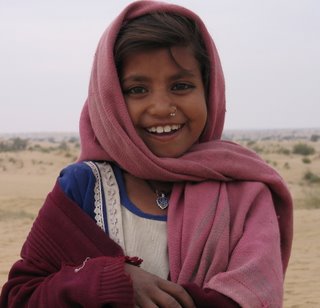
This little girl is not from the shelter. She is, however, their peer.
 My roommate Jenna and I in our sari finery.
My roommate Jenna and I in our sari finery. My roommate Jenna and I in our sari finery.
My roommate Jenna and I in our sari finery. The Birla Mendeer - a Hindu temple.
The Birla Mendeer - a Hindu temple.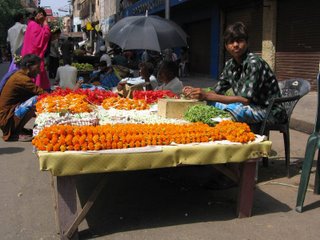 A flower vendor in Calcutta's Chinatown. His flowers are mainly used as religious offerings and decorations.
A flower vendor in Calcutta's Chinatown. His flowers are mainly used as religious offerings and decorations. Playing soccer in a public park after the rains.
Playing soccer in a public park after the rains. Rush hour (i.e., every hour).
Rush hour (i.e., every hour).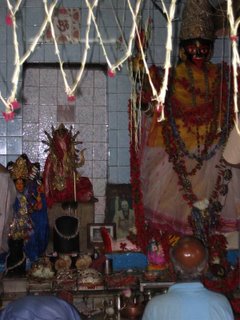 A Hindu temple to Kali, goddess of destruction (among other attributes).
A Hindu temple to Kali, goddess of destruction (among other attributes).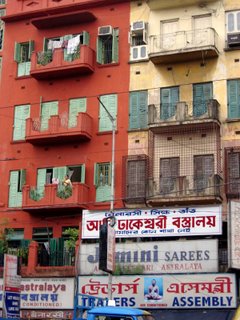 A house on one of the main roads.
A house on one of the main roads. Kids on their way to school.
Kids on their way to school.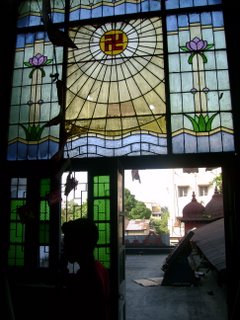 Bengali architecture. This is not, of course, featuring a Nazi symbol - but the Hindu symbol of good fortune.
Bengali architecture. This is not, of course, featuring a Nazi symbol - but the Hindu symbol of good fortune.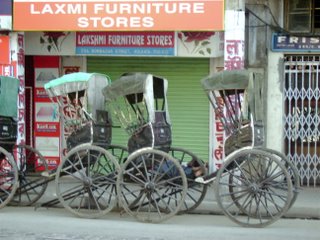 Waiting rickshaws.
Waiting rickshaws. An old family house that has now been divided up by squatters.
An old family house that has now been divided up by squatters. More Bengali architecture.
More Bengali architecture.
 The Howrah Bridge that connects Howrah with Calcutta. It is said that it is the busiest bridge in the world.
The Howrah Bridge that connects Howrah with Calcutta. It is said that it is the busiest bridge in the world. Earning a living on the river.
Earning a living on the river. Bathers at one of the ghats lining the river.
Bathers at one of the ghats lining the river.


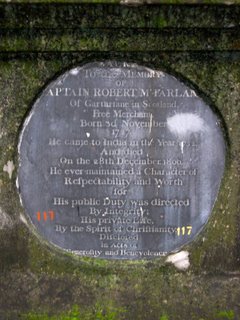


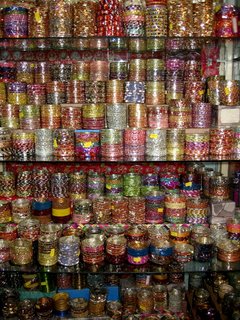 Beautiful Bangles
Beautiful Bangles Bengali sweets are famous throughout India - Calcutta boasts the most sweet shops in the entire country, over three hundred.
Bengali sweets are famous throughout India - Calcutta boasts the most sweet shops in the entire country, over three hundred. Buy them in a ritzy store, buy them in a closet size stall, buy them off the street - you can't walk two feet without tripping over a sari seller.
Buy them in a ritzy store, buy them in a closet size stall, buy them off the street - you can't walk two feet without tripping over a sari seller.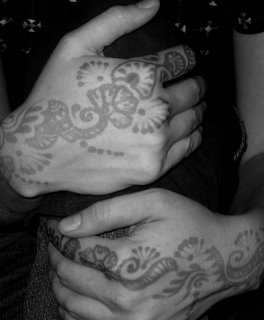 Mendi (Henna) is traditionally done for weddings, but has become a more trendy, daily accessory.
Mendi (Henna) is traditionally done for weddings, but has become a more trendy, daily accessory.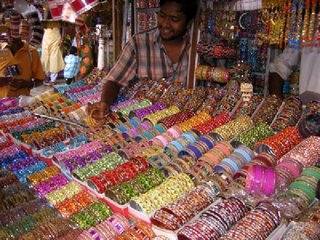 More beautiful bangles. And no, I do NOT have a bangle problem.
More beautiful bangles. And no, I do NOT have a bangle problem.
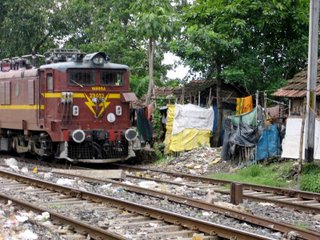 This slum has spread all the way to the train tracks.
This slum has spread all the way to the train tracks.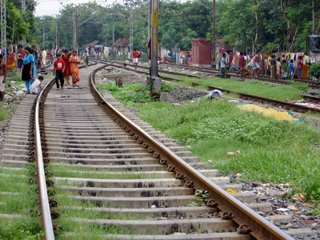 A whole community of people living right on the tracks.
A whole community of people living right on the tracks.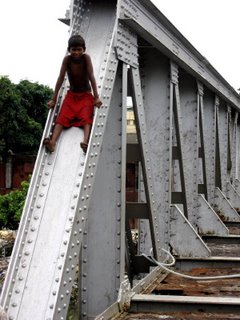 Rails with a view.
Rails with a view.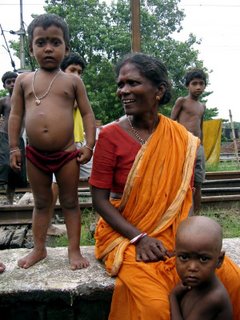 Resting on a Sunday afternoon.
Resting on a Sunday afternoon.

 This summer I have primarily been orbiting around the office world of my NGO. However, once or twice a week I make my way to the village of Narendrapur, which lies on the outskirts of Calcutta in the 24 Parangas. At the boundary line on one far edge of the village, the Snehe Shelter Home is located behind a screen of nodding palm fronds, which brush against the high brick wall surrounding it. After a ride of three busses and a bicycle rickshaw (or one bus, two auto rickshaws and a bicycle rickshaw) the gatekeeper’s eyes peer at me from the narrow face grill of the gate before unlocking and allowing me in.
This summer I have primarily been orbiting around the office world of my NGO. However, once or twice a week I make my way to the village of Narendrapur, which lies on the outskirts of Calcutta in the 24 Parangas. At the boundary line on one far edge of the village, the Snehe Shelter Home is located behind a screen of nodding palm fronds, which brush against the high brick wall surrounding it. After a ride of three busses and a bicycle rickshaw (or one bus, two auto rickshaws and a bicycle rickshaw) the gatekeeper’s eyes peer at me from the narrow face grill of the gate before unlocking and allowing me in.  This little girl is not from the shelter. She is, however, their peer.
This little girl is not from the shelter. She is, however, their peer.
